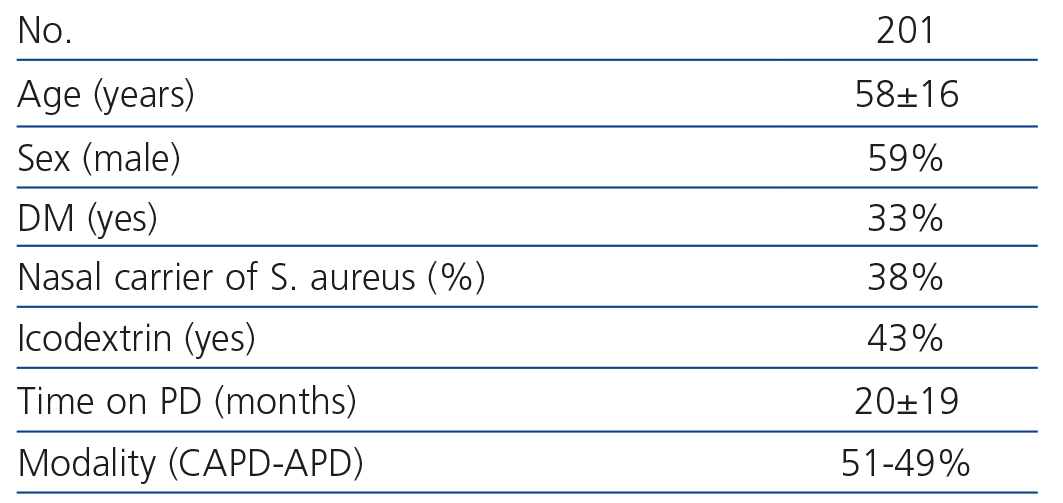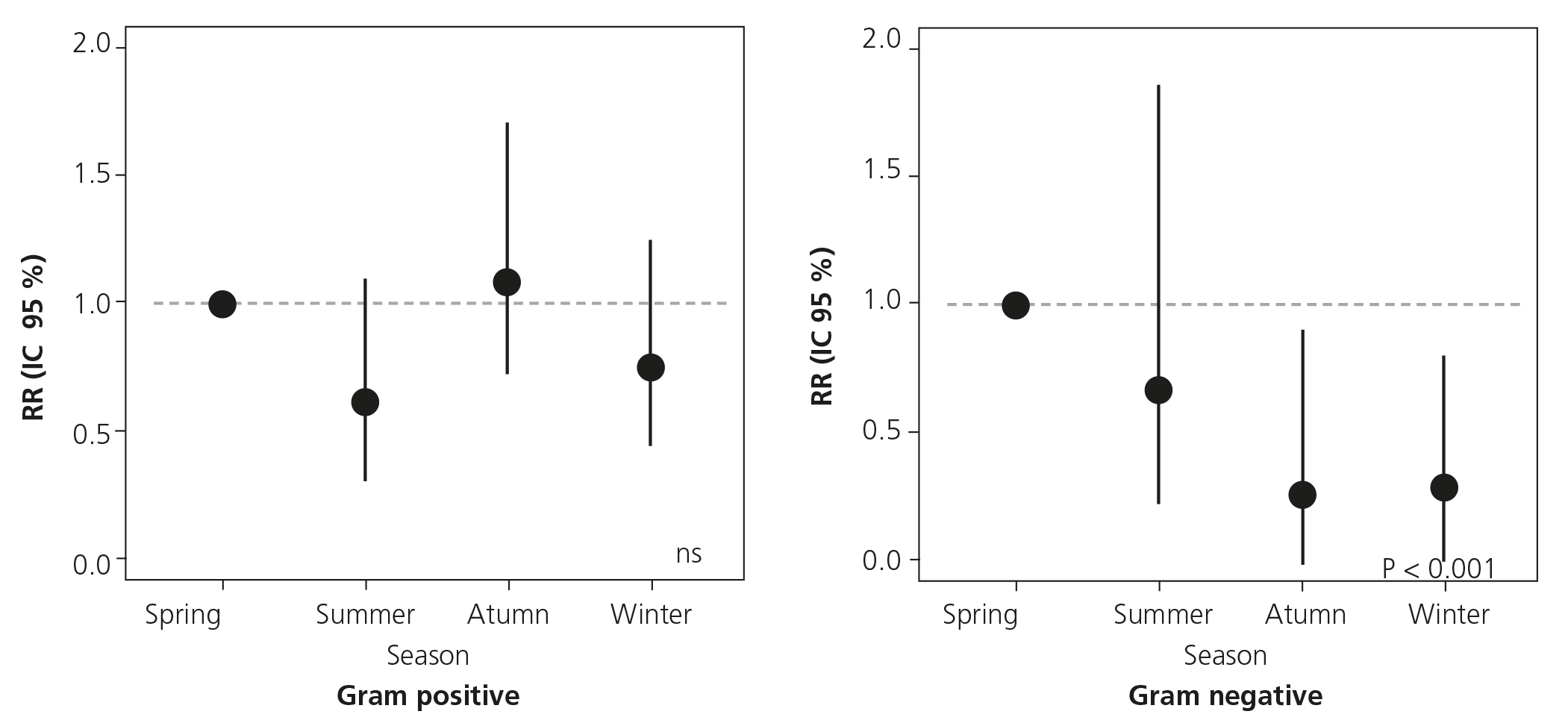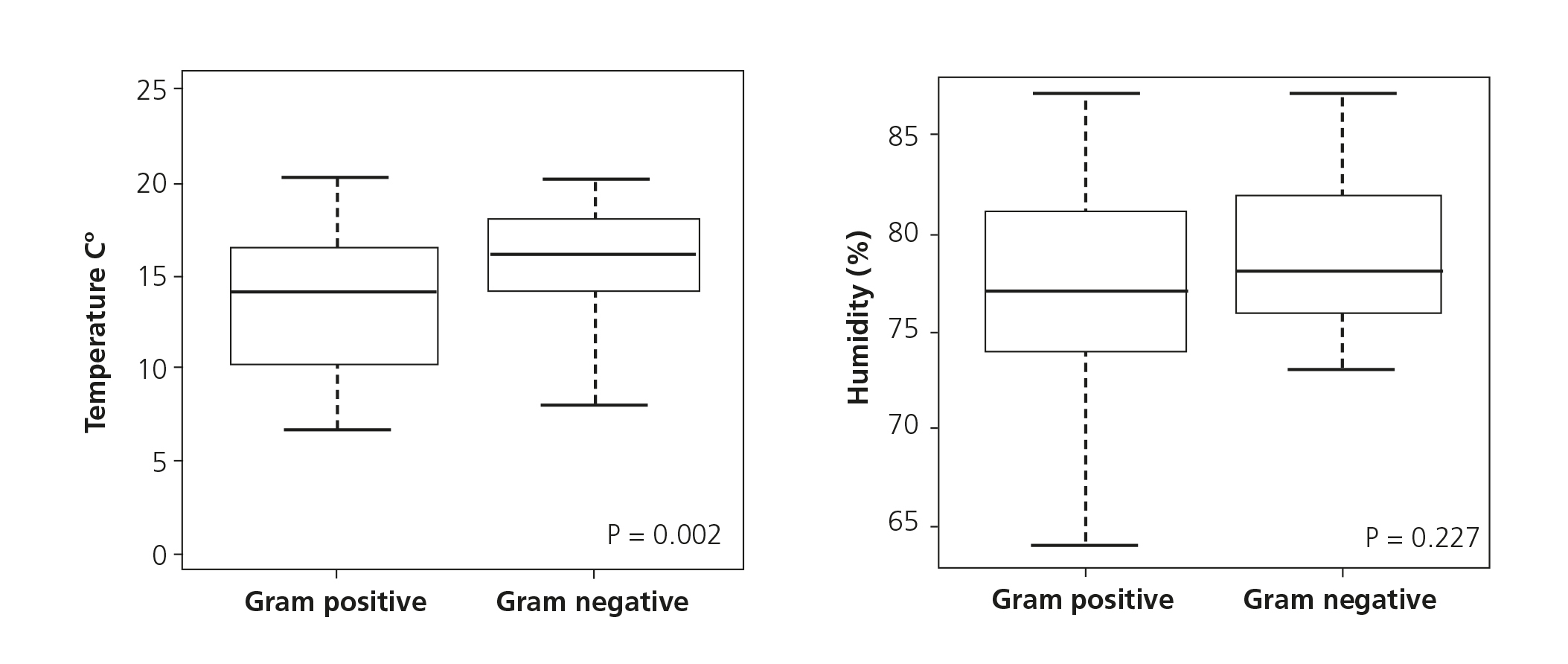Introduction: Peritoneal infections are a common complication in patients undergoing peritoneal dialysis (PD) and are frequently the cause of the failure of the technique. Knowing the factors that can lead to their appearance helps to establish preventative measures. Aim: To understand the influence of climatic variables in the appearance of peritonitis, such as seasonal variation, the temperature and humidity in Asturias. Method: A retrospective, observational study of all peritoneal infections that occurred in our PD department over a period of 5 years (2007-2011). The region was divided lengthways into three areas: the coast, central area and mountains, each of which has a climatological season for reference, which is defined by the State Meteorology Agency (AEMET) (in Gijón, Oviedo and Mieres, respectively). The AEMET provided us with data on the humidity and average temperature of the months in which all the cases of peritonitis appeared. Results: There were 171 cases of peritonitis (0.498 episodes/patient/year) in 201 patients (58±16 years, 59% males, 33% diabetics, 20±19 months on technique). We did not find any differences according to age, sex, having diabetes, nasal carrier status for Staphylococcus aureus or therapeutic modality. Overall, there were no differences among seasons. However, using spring as a reference (value 1), the incidence rate of gram-negative peritonitis (95% confidence interval) in summer, autumn and winter was 0.666 (0.211-1.832), 0.248 (0.000-0.912) and 0.292 (0.000-0.833), respectively (P<.001). We do not see this variation upon analysing the incidence rates of peritonitis caused by gram-positive bacteria. The average temperature of the days on which peritoneal infections were caused by gram-negative bacteria (15.46±3.71°C) was significantly higher than on those days when it was caused by gram-positive bacteria (13.61±3.89 °C) (P.022). There are no significant differences in relation to humidity (78.76 ± 4.40 vs. 77.5±3.69 %) (P.227). Conclusions: Overall, the rates of peritoneal infection are similar in all four seasons of the year, although in the case of gram-negative bacteria there is an increase in its incidence in spring and summer. The higher the temperature, the higher the risk that a peritoneal infection will be the result of a gram-negative bacterium.
Introducción: La infección peritoneal es una complicación común en los pacientes en diálisis peritoneal (DP) y una causa frecuente de fallo de la técnica. Conocer los factores que predisponen a su aparición ayuda a establecer medidas preventivas. Objetivos: Conocer la influencia de variables climáticas en la aparición de peritonitis, como son las variaciones estacionales, la temperatura y la humedad en Asturias. Métodos: Estudio retrospectivo, observacional, de todas las infecciones peritoneales acaecidas en nuestra unidad de DP a lo largo de un período de 5 años (2007-2011). La región fue divida longitudinalmente en tres áreas: costa, medianías y cordillera, cada una de las cuales dispone de una estación climatológica de la Agencia Estatal de Meteorología (AEMET) de referencia (en Gijón, Oviedo y Mieres, respectivamente). La AEMET nos proporcionó los datos de humedad y temperatura media de los meses en los que se produjeron todas las peritonitis. Resultados: Se produjeron 171 peritonitis (0,498 episodios/paciente/año) en 201 pacientes (58 ± 16 años, 59 % varones, 33 % diabéticos, tiempo en técnica 20 ± 19 meses). No encontramos diferencias en función de la edad, el sexo, la condición de diabético, el ser portador nasal inicial de Staphylococcus aureus ni la modalidad terapéutica. Globalmente, no hubo diferencias en las distintas estaciones. Sin embargo, usando la primavera como referencia (valor 1), la tasa de incidencia de peritonitis por gramnegativos (95 % intervalo de confianza) en verano, otoño e invierno fue 0,666 (0,211-1,832), 0,248 (0,000-0,912) y 0,292 (0,000-0,833), respectivamente (P < 0,001). No constatamos dicha variación al analizar las tasas de incidencia de las peritonitis causadas por gérmenes grampositivos. La temperatura media los días en los que se produjeron infecciones peritoneales por gérmenes gramnegativos (15,46 ± 3,71 °C) es significativamente mayor que en los grampositivos (13,61 ± 3,89 °C) (P 0,022). No hay diferencias significativas en cuanto a la humedad (78,76 ± 4,40 frente a 77,5 ± 3,69 %) (P 0,227). Conclusiones: Globalmente, las tasas de infección peritoneal son semejantes en las cuatro estaciones del año, aunque en el caso de los gérmenes gramnegativos en primavera y verano se produce un aumento en su aparición. A mayor temperatura, mayor riesgo de que la infección peritoneal esté causada por un germen gramnegativo.
INTRODUCTION
A historical concern, common to all units of peritoneal dialysis (PD), is the reduction of peritonitis incidence. The continuous technique evolution, with changes in connections, catheters or dialysate has allowed some units to achieve rates of 1 peritonitis/patient/53 months1. Even so, peritoneal infection (PI) is the most important complication of PD, not due to its fatality rate, which is 4%, but due to its influence on patient survival and long-term failure of PD1,2.
There are multiple factors related to PI3 from socio-cultural level, or distance to the PD centre, to “coach” experience4, patients’ moods (depression versus euphoria1,5), exit site infection6 or days of the week7.
Chan8 analysed the relationship between the seasons and the onset of peritonitis, and saw an increase in the number of cases of peritonitis caused by Gram-negative bacteria and Staphylococcus epidermidis in the warmer months of the year. Subsequently, other Asian and Oceania authors established a relationship between humidity and environmental temperature and increase of peritonitis9-11. We are unaware of any European study relating increases in PI with the season of the year. Nor has the influence of climatic factors such as temperature and humidity been studied.
The aim of this study is to analyse the influence of climate on the occurrence of peritonitis in our region, in order to develop the best strategies for prevention.
MATERIAL AND METHOD
Retrospective observational study of all PI diagnosed in our PD unit over a five-year period (2007-2011). We included all prevalent patients on PD due to stage 5 chronic kidney disease within the study period.
All patients had a Swan-Neck high flux (Fresenius Medical Care ®) peritoneal catheter, implanted by the Department of Surgery. Antibiotic prophylaxis with cefazolin, or vancomycin if allergic, was administered preoperatively. All patients used biocompatible solutions (Bicavera®/Phisoneal®). The study was approved by the ethics committee of our hospital.
Exposure time was the period between the start of the technique at home until the end of the study period or until the patient left the PD programme.
The following variables were considered: age, sex, diabetes (yes/no), place of residence, mean environmental temperature and mean environmental humidity on the day when the infection occurred, nasal carriage of Staphylococcus aureus, modality (continuous ambulatory peritoneal dialysis or automated peritoneal dialysis [CAPD/APD]), use of icodextrin, outlet site infection and/or subcutaneous tunnel and/or peritonitis from the time of catheter implantation to beginning procedure at home, episodes of peritonitis and germs responsible for these.
The Spanish Meteorological Agency (AEMET) in Asturias has three weather stations located in Gijón, Oviedo and Mieres. For this study, we divided the region into three areas longitudinally, so that the different municipalities where patients lived could be assigned to a weather station. Consequently, we believe that the climatic conditions in Gijón may reflect those of the coastal towns of the region. The data recorded by the Oviedo Station reflect conditions in the nearby countryside (altitude between 100 and 500m above sea level) and finally data recorded at Mieres reflect the situation of the municipalities closest to the Cantabrian Mountains (above 500m of altitude).
We considered PI to be any episode of unclear peritoneal effluent with a pathological cell count (more than 100 cells/mm3 with a percentage of polymorphonuclear cells higher than 50%12) we counted re-infections and excluded relapses, refractory peritonitis and polymicrobial infections13. We also excluded infections that occurred during periods of hospitalisation outside our region and/or secondary community interventions that could cause them (alpha manoeuvre, colonoscopy, etc.).
Statistical analysis
Categorical variables were expressed in terms of absolute and relative frequencies. Continuous variables were expressed as mean and standard deviations. We calculated annual incidences and confidence intervals (CI) at 95% based on the bootstrap method, which take into account inter-patient variability. Relative risks were calculated by dividing annual incidences. P-values were approximated using a general bootstrap algorithm14, considering values lower than 0.05 statistically significant. All analyses were performed using the free software R2.15 (www.r-project.org).
RESULTS
Population characteristics
Of the 201 patients studied, with a follow-up of a total of 4123 patients-month. The sample characteristics are displayed in Table 1.
Relationship between incidence of peritonitis and seasons of the year
There were 171 infections in 81 patients (40.3%). The mean of infections per patient was 0.851±1.47, with a global incidence of peritonitis of 0.498 episodes/patients/year at risk (95 % IC: 0.395-0.611). We found no age or sex-related differences. There were no differences due to diabetes, initial nasal carriage of Staphylococcus aureus or form of treatment.
For each season, mean follow-up in days was: Spring 150.1±148.3, Summer 163.9±151.6, Autumn 164.6±148.5 and Winter 140.2±139.2. The seasonal variation of peritonitis can be seen in Table 2. In general, there was a lower relative risk of PI in Summer and Winter, which was not significant. Of the total number of infections analysed, 117 (68.4%) were caused by Gram-positive and 25 (14.6°%) by Gram-negative organisms; no growth was observed in other cultures (16.99°%) (Table 2). The rate per patient/year of Gram-positive infections was 0.340 (0.257 to 0.433) and in the case of Gram-negative ones was 0.072 (0.043 to 0.106) (P<.001). If we use risk in Spring as a reference (value 1), the observed relative risk of developing Gram-positive peritonitis was 0.611 (0.315 to 1.082) in Summer, 1.078 (0.717 to 1.688) in Autumn and 0.747 (0.439 to 1.232) in Winter No significant seasonal variation was seen (P 0.122). However, in the case of Gram-negative peritonitis, using Spring as reference, the relative risk for Summer, Autumn and Winter was 0.666 (0.211 to 1.832), 0.248 (0.000 to 0.912) and 0.292 (0.000 to 0.833), respectively. We thus proved that the risk of infection in Spring is four times greater than in Autumn and three times greater than in winter (P<.001) (Figure 1).
Association between peritonitis, temperature and humidity
We found that the average daily temperature on the days when peritoneal Gram-negative infections occurred (15.46±3.71° C) was higher than in the case of Gram-positive ones (13.61±3.89° C) (P.022) Mean humidity was also slightly higher (78.76±4.40 vs. 77.5±3.69%), without being significant (Figure 2)
DISCUSSION
In Asturias peritonitis undergoes seasonal variation, with less risk of occurrence in Summer, very marked in the case of Gram-negative peritonitis, with a relative risk of suffering infections up to four times greater than in Spring.
Until now there have been no published data analysing the influence of seasonal factors on the occurrence of peritonitis in Spain. Different authors have published experiences in other parts of the world. A study carried out in Australia and New Zealand9, with 6610 patients, found no seasonal variation in the overall number of PI, but did find an increase in Gram-negative peritonitis during Summer (December, January and February) and Autumn (March, April and May). In this study, furthermore, they saw seasonal variations in the occurrence of PI due to coagulase negative Staff, Corynebacterium and fungi. These correlations could be due to simple size, the large areas of these countries and climate variations between seasons. Similarly, Szeto11 found an increase of Gram-negative peritonitis in the hottest and most humid months. A Korean11 group noted that in the warmer months there was greater incidence of peritonitis, caused by Gram-positive organisms. These differences with previous studies could be due to small sample size (80 patients) and a high percentage of cultures with no growth (41.5%), far from the quality standards that recommend that cultures without growth should be below 20%15. Finally, Yeoungjee16 compared the rates of PI between temperate and tropical areas, and found that in these last there is less time to the first PI episode and there are more cases of peritonitis. The authors considered the differences were due to low socio-cultural level of the aborigines that live in tropical areas.
We were surprised by the fact that the total distribution of peritonitis during summer had a lower RR.
We thought that this difference could be due to the fact that many patients are on vacation during this season and therefore leave their homes and suffer infections outside the territories we studied. In addition, we know that patients with PI are treated with antibiotics for 2 to 3 weeks, thus reducing the time at risk, which would explain why after a season with a high incidence there follows another season with lower incidence.
The incidence of Gram-negative PI, throughout the year, is heterogeneous, risk appears to increase in Spring by up to four times (compared with Autumn) and three times (compared to Winter).
We agree with other authors that during Spring and Summer, patients enjoy more leisure and could be less “rigorous” when applying the technique5. During these periods there is usually an increase in diarrhoeal episodes, which are clearly in line with PI due to Gram-negative organisms17.
We also found that mean temperatures on the days when Gram-negative PI occurred were significantly higher than on the days when Gram-positive infections occurred. This leads us to suppose that temperature, together with humidity, affect bacterial populations, facilitating and increasing their proliferation16 and patients’ sweating18, which contributes to bacterial transport. The coincidence of these two factors could explain the greater incidence of PI due to Gram-negative organisms during the hottest most humid months in our region.
Based on our data, we consider that quality standards15 should be adjusted according to the climate. The group working in the Levant2, in a study on 1515 patients with characteristics similar to ours, saw an overall peritonitis rate of one episode/patient every 24 months, similar to ours, but with a rate of Gram-negative peritonitis (21%) clearly superior to ours (14.6%). This difference could be explained by the different climates in each region.
It is obvious that retraining is necessary to decrease episodes of IP19. Some authors consider retraining should be performed once a year or every six months20. Considering the forgetting curve of patients and our data, retraining should be carried out in the months prior to Spring (in our geographic location), to decrease the partial rate of Gram-negative peritoneal infections and thus lower the overall rate.
We did not include variables such as outlet site infections, episodes of diarrhoea17, or patients’ socio-cultural level, and consider this limits our results, since we cannot rule out that they may be confounding variables. A multicentre and multigeographic observational study would be able to include a larger sample and greater climate variability, and may further narrow down possible seasonal and climate influence on the development of peritonitis.
We conclude that Gram-negative peritonitis is caused heterogeneously year long, with a greater risk during the warm seasons, especially Spring.
Acknowledgements
Dr. Pablo Martínez Camblor, for his invaluable statistical work.
Dr.Gustavo Fernández Bayón, for his computer knowledge and personal friendship.
AEMET, for all the data.
Conflicts of interest
The authors declare that they have no conflicts of interest related to the contents of this article.
Table 1. Characteristics of the population
Table 2. Incidence and relative risk of peritonitis globally and depending on causal Gram germ, according to days at risk for each season
Figure 1. Incidence of peritonitis by season and type of germ
Figure 2. Relationship between onset of peritonitis and climatic variables such as temperature and humidity














